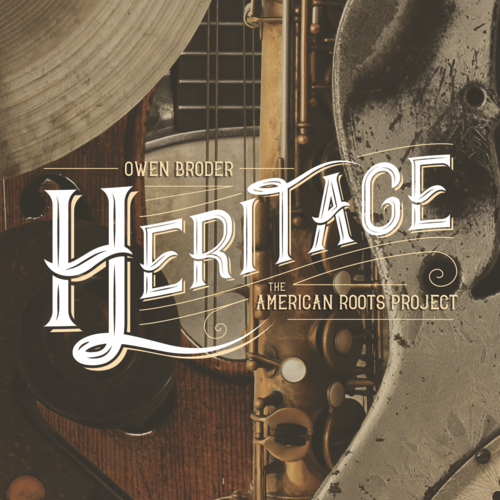Jazz CD Review: Owen Broder’s American Roots Project — Heritage
I’ve never run across music like this and never had even a platonic notion of what such a hybrid would sound like.
Heritage: The American Roots Project

By Steve Provizer
Leader Owen Broder’s goal in this recording is to “intertwine” folk, blues, and spirituals with jazz. I’ve never run across music like this and never had even a platonic notion of what such a hybrid would sound like. Going in, I might have said “it can’t be done,” but I would have been wrong.
Broder’s approach was savvy: amass a group of composers and arrangers who share his overall vision, but whose work is dissimilar enough to explore different approaches to the challenge. He brought in an all-star group, including Jim McNeely of the Vanguard Orchestra, Ryan Truesdell, founder of the Gil Evans Project, and Bill Holman, who has written for just about any jazz group — big or small — that you can think of.
To perform the charts, Broder gathered together a group of musicians with a wide enough skill set to render the vision: Broder on woodwinds; Sara Caswell, violin; Scott Wendholt, trumpet; Nick Finzer, trombone; James Shipp, vibes and percussion; Frank Kimbrough, piano; Jay Anderson, bass, and drummer Matt Wilson. Wendy Gilles, Kate McGarry, and Vuyo Sotashe are the vocalists.
A lot of arts reviewing is about “comparables,” as they say on the Roadshow, but that’s tough in this case. Sections can be put into a broader musical perspective, but the way this album is put together is pretty much sui generis. What I will do to help the music take shape in your mind is to go through each tune via a kind of musical shorthand to give you an sense of the resources that have been mobilized to create each composition.
Goin Up Home Owen Broder, composer. The opening combination is vibes and fiddle (I’ll use fiddle when the violin is in “country” mode). Piano and bass enter with a pedal tone, then a repeating vibes figure. Trumpet makes a consonant entrance, then add sax and trombone. The composition moves to a fuller orchestration and starts to swing. Vibes solos. The chords are not complicated, but soloists use harmonic substitutions to bring them up to date. Background lines enter and vibes fade. Trombone enters w. violin obstinato. Bone sticks closer to the harmony. Swing aspect picks up with a double time feel in the solo. Larger orchestration comes in at end of bone solo. Back to the theme, slightly more chromatic, then a return to the original sound. Fades out on violin repeated figure.
Wherever This Road Leads, Miho Hazama, composer. Piano/bass play a repeated figure, on top of which two horns enter. Larger group is briefly in, then horns solo over repeated background with bass/piano. Interesting background lines come in under solos. Violin and then trumpet play written lines, then bone, and a rondo feeling develops with the horns and violin. Stop time. Bone enters with expressive solo in rubato time. His sound reminds me of Mingus bone player Jimmy Knepper. Fiddle comes in with a jig feel, which is picked up by the whole group but with chromatic harmony. Then the violin solos over a repeated figure in the rhythm section. Jig figures picked up by the whole group in and out of the simpler pentatonic line and all fade out.
Jambalaya. Bill Holman, arranger. Violin plays unaccompanied solo with Cajun implications, which is then harmonized with other horns in “modern” classical harmony. Then add a piano, kinda bluesy, with a light rhythm section swing. Horns enter in a clear blues-jazz vein. Violin solos over the jazzy changes in a Stephane Grappelli vein. Then, trumpet enters with a pleasing mainstream solo that shows strong jazz chops. A tutti bluesy line follows, with a counter line. Trumpet plays the line with trombone using plunger mute. Then we move into a solidly big band mode. Ending with a group figure variation on the well-known line Jambalaya.
Cripple Creek. Jim McNeely, arranger. Snare drum starts in a marching tempo with a violin figure, then a piano figure is added. Horns enter with a country-like line. Repeats. Key change. Elaboration on the line, slightly fugue-like. Trumpet solo with group in a post-bop mode. Then, back to the country music line approach. Alto and bone kick in brief solo lines. Alto solo continues with strong background buildup that segues to a brief fiddle line and brief piano interlude, violin and trumpet solos interweave, then joined by bone. The whole thing suddenly shifts to a square dance. Fiddle takes it out a bit, moving into a bluesy vein. A two-beat rhythm section continues and other horns join in on the fracas. More key changes, then a controlled free-for-all ensues. Rhythm section moves from two-beat into a Mingus four-feel. Then, back to a country feel with jazz overtones and a satisfying buildup to finale.
Wayfaring Stranger. Ryan Truesdell, arranger. Piano starts in a slow nebulous harmonic zone and sets a mood reminiscent of the Ran Blake noir piano pieces. Then, a slow minor theme with bass clarinet underneath. Voice enters, approaching the song as a lamentation. Voice in harmony enters with mallets on percussion. We hear sparce background lines by bass clarinet and then violin comes in for an expressive, minimalist solo. The voice comes back; the setting reminding me of some of Helen Merrill’s recorded work. A second voice enters in harmony. Bass does a sparse melodic solo, accompanied by piano. You can hear here more easily the harmonic substitutions they use in the song. Multiple voices in harmony provide interesting background lines with variable pitch. Very unique sound generated here. Fade out with a short atonal stack of instrumental voices.
I’m Not Afraid to Die. Miho Azama, arranger. Flute/violin start over a repeated bass figure. Trumpet enters with theme. Rhythmic feel moves to a steady four. Piano takes over melody and expands it a bit. Trumpet solos. There’s an early ECM quality to this, like an Art Lande recording. Clarinet and trumpet, then the ensemble comes in with multiple strands of solos, a repeated, minimal background figure helps provide shape to the solo.

Owen Broder. Photo: Courtesy of the artist.
Brodeo. Ryan Truesdell, composer. Starts with an ostinato and a violin/clarinet unison figure in a slightly warped contra-band-style line. Key changes, chromatic development of the line. Alto sax states a new melody, picked up by other instruments. It has the quality of that country line, slightly intruded upon by jazz inflections. Violin solo is really just a slight elaboration of the line. Moves into an alto solo, also largely just an expansion of the line with occasional bop-ish flourishes. Rhythm section takes the alto player through the key changes and builds up to a transition to a large ensemble orchestration of the original line with rhythmic variations, swapping measures with the drummer. Then a section of syncopated group “hits.” Some frantic figures follow, still trading with the drummer, repeated several times. Then, we go to a wrap-up coda with fast variations and out.
The People Could Fly. Alphonso Horne, composer. Pedal tone starts with voice on top -Gar oo ga Ku ah. Flute imitates melody, violin chases in 6/8 meter. New voices join in harmony. We go straightforwardly through A and B sections of the song. Vibes solo, then voices back in with an dissonant note of growling muted trumpets. We move to a dirge version of the tune with plunger mute trombone background. Then, trombone solo on plunger a la Tricky Sam Nanton. A sweetish background briefly comes in and out. Solemn voices return, then hand claps. Trumpet and trombone growl in a background which builds to cacophony. Then, single voice to another variation of Ka Roo Ga Ju ah. Double time with voices repeating Ka Ru Gah. Then solo voice joined by harmony in half time while rhythm sections stays in double time. Fade out.
A Wiser Man Than Me. Owen Broder, composer. South African style harmony in voices. Sax enters. Slow tempo. Song has both American country and African feel, also tinge of R&B. Trumpet states the melody. Then, baritone sax. They tend to bring out the R&B as it goes along. This is the most straightforward of the tracks. Baritone Sax solos, then piano with drums in a slow walk. Multiple voices in melodious harmony do a tag ending.
And, in case you don’t think I’ve committed myself, I strongly recommend this album.
Steve Provizer is a jazz brass player and vocalist, leads a band called Skylight and plays with the Leap of Faith Orchestra. He has a radio show Thursdays at 5 p.m. on WZBC, 90.3 FM and has been blogging about jazz since 2010
